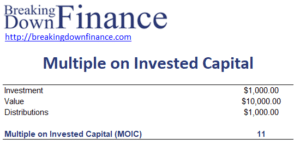Multiple On Invested Capital (MOIC)
The gross multiple on invested capital (MOIC) is a measure of performance that is used to monitor certain types of alternative investments, e.g. private equity funds. Since these funds’ performance reporting tends to be infrequent and with significant time lags they are hard to monitor. Often, these funds report internal rates of return (IRR) rather than time-weighted rates of return. The IRR is influenced by the timing of capital calls and distributions, and therefore, may be subject to manipulation.
On this page, we discuss how investors can use the multiple on invested capital to monitor a private fund. An Excel spreadsheet that implements the formula is available for download at the bottom of the page.
Multiple On Invested Capital formula
The multiple on invested capital is defined as follows:
Expressed in words, the MOIC is a multiple of how much an alternative investment has generated in gains, relative to how much was invested. We should note that, while the MOIC is harder to manipulate by the fund manager, the investor will still need to solve the issues related to stale pricing and appraisal-based valuations. Desmoothing returns can be used to fix these issues.
Example
Let’s consider a simple numerical example that illustrates how we can calculate the MOIC with only a limited amount of data on the private fund. The following table implements the necessary routines. The spreadsheet can be downloaded at the bottom of the page.
As long as the value used in the formula is a fair representation of the current value of the investments, the MOIC will be a reliable measure of performance.
Summary
We discussed the MOIC, a measure commonly used by investors in private funds that report performance using the internal rate of return rather than time-weighted rates of return.
Download the Excel spreadsheet
Want to have an implementation in Excel? Download the Excel file: Multiple on Invested Capital Example

